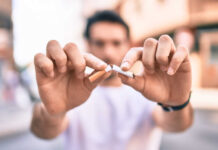
The delicate skin around your eyes requires specialized care that your regular facial products simply can’t provide—yet millions continue to make this critical skincare mistake daily.
At a Glance
- The skin around your eyes is 40% thinner than the rest of your face, making it more susceptible to dryness, fine lines, and premature aging
- Regular facial moisturizers contain ingredients that may irritate the delicate under-eye area or cause puffiness
- Eye creams are specifically formulated with gentler ingredients and appropriate concentrations for this sensitive skin
- Applying eye cream incorrectly (using too much, rubbing aggressively, or placing it too close to eyes) can worsen under-eye issues
- Consistency in application and proper technique are essential for visible results, which typically appear after 30-60 days
Why Your Under-Eye Area Needs Special Attention
The skin surrounding your eyes deserves exceptional care due to its unique characteristics. This area is thinner, more fragile, and contains fewer oil glands than the rest of your face, making it particularly vulnerable to dryness and early signs of aging. Without adequate moisture and protection, fine lines, wrinkles, and dark circles appear more readily here than elsewhere. Additionally, the constant movement from expressions like smiling and squinting puts extra stress on this delicate area. When neglected or treated with inappropriate products, problems like puffiness, irritation, and accelerated aging become more prominent, affecting not just your appearance but also the health of this sensitive skin.
Many people mistakenly believe that regular face creams can adequately address under-eye concerns, but this misconception often leads to disappointing results. Regular moisturizers typically contain active ingredients at concentrations too harsh for the thin under-eye skin, potentially causing irritation or even making concerns like puffiness worse. Furthermore, facial products rarely target the specific issues that plague the eye area, such as dark circles, fine expression lines, and loss of elasticity that occurs more rapidly in this region.
Key Differences Between Eye Creams and Facial Moisturizers
Eye creams are specifically formulated with the unique needs of the under-eye area in mind. They generally contain higher concentrations of active ingredients tailored to address common eye-area concerns while remaining gentle enough for this sensitive skin. While facial moisturizers focus on general hydration and concerns across the entire face, eye creams target specific issues like dark circles, puffiness, and fine lines with specialized ingredients like peptides, caffeine, and vitamin K. The texture of eye creams also differs significantly—they’re often richer and more emollient to compensate for the lack of oil glands in the eye area without being heavy enough to cause milia or irritation.
When selecting an eye cream, consider your specific skin type and concerns rather than simply the price tag. Expensive doesn’t always mean effective when it comes to eye care. Look for ingredients like hyaluronic acid for hydration, peptides for collagen production, antioxidants for protection, and caffeine for reducing puffiness. Those with oily skin should choose oil-free formulations, while dry skin types benefit from more emollient products. The right product for your skin type will deliver results without causing additional problems like milia or irritation.
Proper Application Techniques Make All the Difference
Even with the right product, improper application can sabotage your under-eye care routine. One of the most common mistakes is using too much product. A pea-sized amount is sufficient for both eyes—using more won’t speed up results and may cause irritation, puffiness, or milia. Apply eye cream with your ring finger, which naturally applies the least pressure, using a gentle patting motion rather than rubbing or tugging. Start application at the outer corner and work inward, staying about a half-centimeter away from the lash line to prevent product migration into the eyes during sleep.
Timing matters in your skincare routine. Apply eye cream on freshly cleansed skin, and allow it to fully absorb before applying other products or makeup. For most routines, eye cream should be applied after serums but before heavier moisturizers. Nighttime application is particularly beneficial as this is when skin cells regenerate most actively. Be patient with results—visible improvements typically require consistent use for 30-60 days, as the skin cell turnover cycle takes approximately one month. Expecting overnight miracles often leads to disappointment and abandonment of products before they’ve had a chance to work.
Beyond Products: Lifestyle Factors That Affect Under-Eye Health
Even the most expensive eye cream can’t compensate for certain lifestyle factors that affect the appearance of your under-eye area. Inadequate sleep is perhaps the most significant contributor to dark circles, puffiness, and dullness in this region. Aim for 7-8 hours of quality sleep with your head slightly elevated to prevent fluid accumulation that causes morning puffiness. Hydration plays a crucial role too—both internal hydration from adequate water intake and external hydration from appropriate skincare products. Diet also significantly impacts under-eye appearance, with foods rich in antioxidants, omega-3 fatty acids, and vitamins A, C, and E supporting skin health.
Finally, sun protection is non-negotiable for preserving under-eye health. This delicate area is particularly vulnerable to UV damage, which accelerates aging and worsens existing concerns like dark circles. Consider using eye creams with SPF for daytime or wearing sunglasses when outdoors. When these lifestyle factors work in tandem with appropriate product selection and application techniques, you’ll maximize the health and appearance of the under-eye area for years to come, preventing many common concerns before they become difficult to address.


















